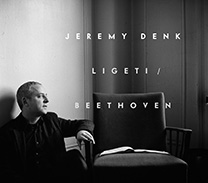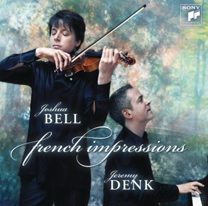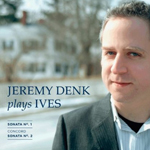I’m delighted to report not only did this blog appear in the Wall Street Journal, but has been selected at Top Ten Sources as one of top ten sources for classical music. Thanks to both. And while we’re tooting our own horns (thereby causing horns of a different sort to sprout from the top of our heads), anyone in the New York area is cordially invited to Friday night’s concert at Miller Theatre (Columbia campus), where I will be playing the Berg Chamber Concerto with the amazing Mark Steinberg and Reinbert deLeeuw is conducting a tremendous band of wind and brass players.
Enough of all that. Jeez.
Such is my influence in the classical music world, now: regular reader R J Keefe is apparently dreaming up pretentious things to say to his wife at the Dec. 3rd Carnegie concert, so that I can overhear them and write about them disparagingly! I advise all attenders to keep their ears perked, and not solely to the performance. An update: he was not the person I overheard, so I issued an unnecessary apology for offending someone else; but I stand by my weaselly retraction. So there.
The question remains: do I have something to say of substance in this post? Or am I just wasting pixels? Well, yesterday I came out of the gym at around 9 PM, having turned the Stairmaster up to an unprecedented level 12, and my brain was awash with nearly hallucinogenic inspirations. I had this vision of myself beginning Op. 111 Beethoven (the thousands? of times I have begun it), and all the different mental states and types of attention I have brought to it. It was an image hard to hold in the hand, with immense variety of scale: sometimes just a flea, trying to mentally get myself squeezed in the space between the fingertip and the key, trying to calibrate those micro-motions, and sometimes telescoping out, not just to the whole piece, not just all of Beethoven, but trying to take in all of Western music–since Op. 111 kind of stands out as a landmark in it somewhere, perhaps on the edge of a cliff.
As I was walking home I was thrilled by the idea of somehow capturing in writing, seizing with the pen, my sense, all at once, of this “total 111 experience.” No, I don’t think any one, even unbelievable, performance, can capture this total experience… an individual performance is not a sufficient place for all your past learnings to take shelter. Each performance is partial, part of a larger text, which you write within yourself, which you gradually compose. If only you could pour out that larger text onto an audience, how wowed they would be! But they are busy composing their own texts.
So this all-at-once vision is impossible. But when I reach into my brain to find it, this impossible entity, I come back with things. What I saw mainly when I was trying to find my total 111 was much closer to forgetting, closer to a series of false starts, than to any integral, faithful memory. The piece for me, more and more, is a million (now a million plus one) fragments, and each performance is like a desperate attempt to reassemble. I know too much; luckily the piece seems partly to be about knowing too much. (Beethoven has seen so many sonata-allegro movements, so why not dispense with some formalities? Condense matters? But perhaps we miss them?) When I reach in, I get a strong vision, for example, of practicing it in my friend Evelyne’s living room in Bloomington, while she was working in the next room, and what I remember was enjoying the very grain of C major, how beautiful it was, in the live acoustic of that wood-filled room, and how I wanted to prolong and understand simply the consonances, the thirds and sixths, and partly to eliminate anything that intruded on the C major, on the sensual satisfaction of it. But the piece is full of things that must intrude on this sensual satisfaction… therefore my love for it at that moment was in part a reduction, a disservice. But Evelyne came in and we were talking about how beautiful it was, and it was a sincere moment of communication about music (reasonably rare) in which both of us seemed to understand the terms on which our tentative statements were based. And then there is the moment where I played it at a noontime concert in Spoleto, Italy, after a jetlagged night of absolutely no sleep, and all I remember is a really wild jazzy variation in the second movement, a sense of total technical command and lack of fear for that moment.
All day long we dredge into our brains to solve some impossible problem … we ask it “What is my total experience of 111?” or “What do I want to do with my life?” etc. etc. and somehow the brain is not a computer that freezes up or crashes in the face of impossible demands but bravely offers SOMETHING, anything, temporarily even, to make its owner (?) happy. And I find it fascinating to see what my brain offers me about that piece right now: what comes up from the murk and says hello, why is it important to me, what do I take for granted and what is missing. This little collection of memories, fragments of intense moments I shared with the piece (including a night when I practiced the opening trill the “wrong way,” a night when I was cramming the piece for a concert that was too soon, an exhausting evening in Bloomington after a long day playing it in Indiana Univ., etc.), these come up, and I extract from each some insight about the piece, something to add, something once ventured and never found again.
Not to belabor the point, but I feel like Beethoven’s compositional life must have been, at some point, like that. Asking his own brain an impossible musical question. Reaching into the murk (the world of compositional possibility) for one thing, one idea, change, something your brain offers you to do different; then so many consequences following on these little revolutions. Which is partly why we think of the searching, heaven-storming Beethoven, the questioner; which is not just the questioner of musical “tradition,” but the questioner of musical language, of expression itself, of how to attach ourselves onto some end of the impossible infinity of the questions we ask ourselves.



3 Comments
I was meaning to leave a note here the other day in response to your comments on the Berg Chamber Concerto (a favourite piece). But I didn’t get round to it, and now, on returning, I see you were playing it with Reinbert de Leeuw, who conducted a lovely performance of a piece of mine in Sydney earlier this year. I’d have liked to send him my regards.
But back to Berg and your blog. What I wanted to say is how refreshing it is to read some writing that is actually about music – I mean about the dots – rather than just an emotional response to music. And the whole-tone connection you point out of course makes me think of the Berg Violin Concerto and the tone row that ends with a whole-tone sequence which just happens to be the start of ‘Es ist genung’.
I’m not a big blog reader, but I shall return to read you again. Best wishes and good luck with the Bach and Beethoven.
I need a new publicist for my blog.
Was that the little Caio Melisso theatre, in Spoleto? I love that place, and I think it’s a very beautiful setting for any kind of concert!
Ciao, and thanks again for your inspiring writing.
macubu